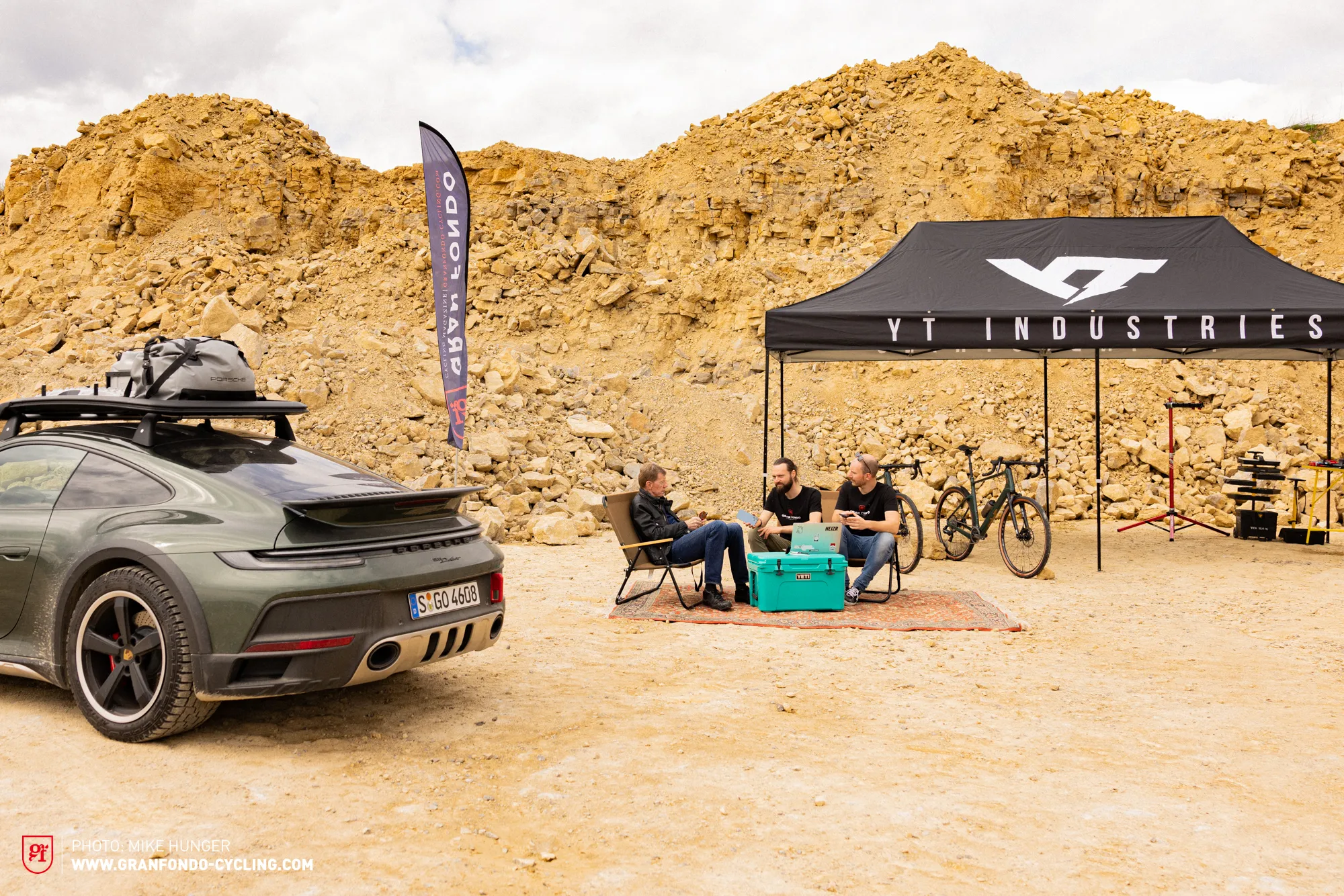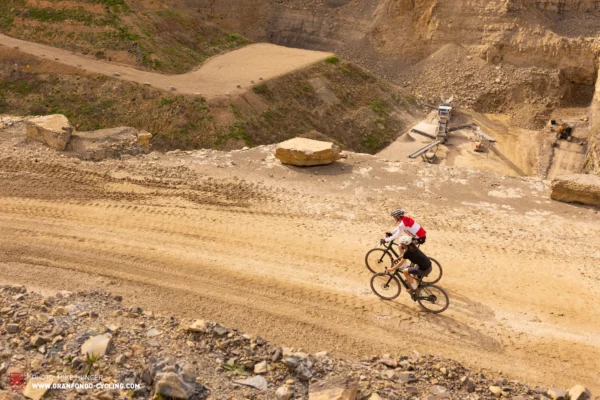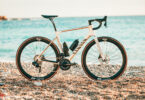If anyone can fly over gravel roads, it’s Walter Röhrl. Teaming up with the rally legend, with the new YT Szepter and the new Porsche 911 Dakar, we spent a day spraying gravel in gravel paradise. Find out why Walter’s doctor certified him with a screw loose, why he drove Eddy Merckx to despair, and why he might have become a cycling world champion!



A deafening noise fills the air and great clouds of dust billow up the slope. Fortunately, there is no blasting at our quarry edge today. The quarry’s heavy excavators and dump trucks are still in full swing, and we are right in the middle of it, making the final preparations. The YT team is already there, and of course YT founder and petrolhead Markus Flossmann wouldn’t miss the opportunity to drop by in person. Our plan is to kick up some dust, let the gravel fly, and have a great time! And all that right where the holy gravel is made – in the quarry, or to be more precise, in the Baresel quarry in Ehningen, which is less than 20 minutes away from our office. Along the way, we will interview 76-year-old rally legend Walter Röhrl and find out what gravel bikers can learn from rallying. And if there’s anyone we can learn from, it’s the Grand Master himself.
Walter has 50 years of racing experience, two world championship titles and fourteen rally victories under the bonnet. He should know how to fly through wide gravel bends if anyone does. What many people don’t know is that he’s also exceptionally skilled on a bike.
The unusual idea came from GRAN FONDO founder Robin, who also enjoys kicking up dust – on four wheels or two. He has driven his historic 911 Porsche through the Moroccan desert and ridden the new Szepter through the dust of California. With this in mind, we were all the more excited to see how a professional – sorry, a legend – does it!

Walter very nearly couldn’t come at all. A lingering cold almost ruined our meeting. Luckily, he came anyway because he was just as excited about the day as we were!
Here we go. Fasten your seat belts! Even in his mid-seventies, Walter still hasn’t found it in him to slow down. A reverent silence fills the air as Walter turns the ignition key on the left of the steering wheel. The 6-cylinder boxer engine howls. He presses the ESP switch to deactivate it. Ready? With a quick nod, Walter puts the spurs to the 480 horses under the hood. With incredible calm and precision, he steers along the marked route. He lines up the Dakar in the direction he wants to exit the bend before he even enters it and drifts with the nose of the car extremely close to the inside of the corner. His feet don’t quite dance like in the legendary videos.The reason? The 911 Dakar has an automatic gearbox. The fact that there is a drop of 30 metres into the abyss on one side leaves us unfazed: we are in the car with Walter. This man does not rely on luck but on perfection – exclusively. And he knows no mercy. Like a speedboat, we glide over the gravel, take the bumps, and drift around every corner with impressive aplomb. The faster we go, the calmer Walter and his steering become. And the sound of the gravel intensifies as it hits the wheel arches like hail. Round 1 is over. And there are many more to come. In between, there’s a lot of technical talk, tips and advice.




The sun is burning through the clouds and a long day is still ahead of us. Let’s take a break. We are all hungry. As with all our GRAN FONDO productions, Mommie Schmitt has cooked for us and brought organic quiche with a vegetable platter for everyone. No catering fuss, just homemade and delicious food! Mommie Schmitt then immediately engages Walter with some personal questions – has a secret fan sneaked in? Or is it the start of our interview?





The conversations change and become more personal, which is something that suits Walter’s open-hearted nature. He is not a legend with a “star attitude”, actually quite the opposite. He simply loves what he does and enjoys inspiring others. He’s approachable even though he stands a head taller than everyone around him! His love of animals is also a reflection of his character. When Walter returns from events, he usually spends the whole drive home looking forward to seeing his cats. And of course, our office dog, Henry, gets his share of cuddles too!

Into the bib shorts and onto the YT Szepter. Walter, who is an experienced roadie but has never been on a gravel bike before, is delighted with the control on the rough gravel. He quickly notices the differences to his road bike: tires, geometry, balance, and the dropper post. Nice! Walter effortlessly climbs the steep ramp of the quarry and skilfully does a track stand. It’s obvious he isn’t doing it for the first time. Time to find out where his bike skills come from. We make ourselves comfortable at the base camp and begin our interview.



Walter Röhrl and cycling, how did it all start?
It was in 1984 when I was a driver for Audi. There was a bike race in Giessen, a charity event for children with cancer. The marketing manager at the time was absolutely thrilled by the idea. I had neither a racing bike nor any racing experience myself, but he put my mind at rest and said it was only 30 kilometres. So I thought: Why not? On arrival in Giessen, the situation changed when the head of marketing approached me and revealed that the actual distance was a whopping 130 kilometres – for goodness sake! I decided to stay in the slipstream, save my energy, and somehow make it to the finish. After the first 30 kilometres, we were already on the Feldberg. At this point, I was ranked about 100. But the climb went so well that when we reached the top of the Feldberg, there were only three of us left:
Didi Thurau, Klaus-Peter Thaler (editor’s note: two of Germany’s best cyclists) and me. The two of them started joking: “Look, another motorsport athlete who uses the bike only for his fitness training”. So I told them that I had never been on a road bike in my life. They were stunned and immediately invited me to come to training camp with them. I ended up spending a week with the pros in the Black Forest. My introduction to cycling – and a fantastic time!

I have to admit that I’m extreme in everything I do. Cycling is no exception. I’ve driven many a professional cyclist to despair in the mountains – Eddy Merckx in particular – and I still have a lot of fun on the bike. But nothing works without a training camp. You have to do it! I’ve always kept a training log, of course, and must have cycled a good 42,000 km by now.
“Next year I’ll be back at the training camp in Mallorca.”
In an alternative life, would you have considered a career in cycling?
Sure, that would have been a possibility. After Klaus-Peter Thaler became cyclocross world champion for the fourth time in 1987, he took me to a performance test on the “Oppenauer Steige” on the last day of the training camp. 8 km with a gradient of 8.6%. Klaus said: “Don’t stress yourself out, go at your own pace, I’ll wait for you at the top.” He didn’t have to wait! That stressed him out (laughs).
How were you able to combine cycling with your rally career?
Cycling has given me so much. I took my bike with me everywhere – on the rally stages and later on the test drives. After two hours on the bike, the stress was gone and my head was clear. Fantastic! I also benefited from it in terms of stamina during the rally, because after 40 hours of driving you need all your reserves of fitness and concentration. At the end of the day, I was a few minutes faster than my competitors who didn’t have the same physical condition. Besides, there was always an environmental aspect to it for me. I said to myself: “Come on, you drive cars all the time. Take the bike whenever you can.” So I travelled by bike wherever possible, often to Austria for holidays or to Graz for car tests.
Cycling gave me a lot of zest for life. It’s still fascinating to see what the pros can do on a bike today. You can only judge that if you have cycled yourself!


Where do you see parallels between rally driving and cycling?
Driving needs to flow: smooth, round, clean.
I have a similar view on road cycling. You have to feel the right line. You also have to be a bit crazy: these days, when I ride down my local mountain, I sometimes think to myself: what if I fall at 70km/h? We didn’t think about any such thing when we were younger. My old bike computer could only measure up to 99.9 km/h and would start flashing above that speed. Of course, it flashed all the time.
There is one important rule when driving a car: steer as little as possible. You can drive at full throttle all the way to the bend, and you have to maintain that for as long as possible. Braking later means being faster for longer. It’s as simple as that. Steering as little as possible, early enough, and using the road to the limit is certainly the key.
Of course, the same principle applies to cycling. That was the only reason I won my first and only bike race in Siegen. On the last few kilometres before the final sprint, on a steep descent, I was able to overtake on the outside thanks to my feel for the curves. By the time I got to the flat stretch, I was already too far ahead for my pursuers. Finding the right line is crucial in both sports and one of the keys to success. Equally important for me was visually memorising the course in my head. If you can do that, you have an advantage. You can get into the flow quicker, think ahead better, and drive less reactively. To memorise the track in this way, you have to be 100% focused during training. During the 12 hours of training, I didn’t talk to my co-driver for five minutes. Meanwhile, other teams were telling each other their whole life story. For us, concentration was everything: memorising every key point, developing a plan for everything. Maybe a bit pathological – but successful!
It’s also important to be critical. I tried never to rely on luck.
After each stage, I analysed exactly where I had been lucky.
While other riders were rejoicing over successful daredevil manoeuvres with two wheels on the edge of the ditch, I was putting myself under a lot of pressure. I wanted to identify and analyse all my mistakes to avoid them in the future. It’s also thanks to this striving for perfection and control that, after 50 years of motorsport, my body is still in good enough shape for me to ride a bike without any problems.

What advice would you give us mere mortals and beginners to quickly become better drivers?
The best way to improve your driving skills is to do winter training on ice and snow: it’s the quickest way to gain control of the vehicle. You get a feel for when the car starts to swerve, when to take the steering back, and how much to counter-steer. And the speed doesn’t have to be high at all. This training is really good to start with and very effective. I can imagine doing something similar on a gravel bike – where falling doesn’t hurt as much, of course!
The challenge is to find the right balance: don’t push too hard, learn in small steps, and ajust the set-up to your own body. After all, the steering wheel is a steering wheel, not a holding wheel. This means that the fit should allow you to steer easily.
In a bend, every movement of the accelerator must be synchronised with the steering, otherwise you will always be too late. Especially with the Porsche, which carries its mass at the rear, you have to counteract the momentum with the steering as it builds up. If the rear breaks away and you hesitate for a tenth of a second before you react, it’ll already be too late. In general, the entrance to a bend should be the slowest point. The front axle must lead. You can catch a rear end that breaks away, but if the front tires lose grip, you will slide until they find grip again.


What is your opinion on assistance systems?
Of course, assistance systems such as ESP and ABS are important and play a major role in reducing the number of road fatalities. But if you want to drive your car for fun as well as for everyday use, you’re lucky if you can still take full control. The beauty of the bike is that you still have to manage everything yourself. The responsibility is entirely yours, which means you have to know what you’re doing. I just love that.
“The only thing he could certify me with, though, was a loose screw.”
How does the driving style change with age?
You become more sensible and take fewer risks. It’s ironic, actually. When you were young and had your whole life ahead of you, you went for it. And now, with a relatively short time left, you are suddenly afraid that something might happen. Age also means gaining experience, and with time you become aware of everything that can happen.
Even the body starts to show its age at 76. Admitting it is another story, though. When I was struggling on the last ski tour, I went to see a doctor friend. I was convinced that something was wrong with my heart because 30 years ago I had done the same tour 3 minutes faster. The only thing he could certify for me was that I had a screw loose. When you are 76, you have to realise that you should not compete with your own performance from 30 years ago. I don’t rev my classic cars above 3000 rpm to protect the engine, and I should get used to doing the same with my body. Because at the moment, I’m still living life at full throttle.

Should life be fast or slow?
As I get older, it feels like time goes by faster and faster. It’s a shame, but I still haven’t discovered the pleasure of taking things slowly. On the bike or in the car: I have the time to take it slower, but the desire to cover the distance as quickly as possible is always there. I’m still living my life in the fast lane. Back then, the goal was to win races. Now I want to make the most of my time. The pressure I used to put on myself when I was racing, I now put on myself in my free time. Even if that means I can’t enjoy every moment to the full: my classic cars need moving, I want to ride my bike, and the lawn won’t mow itself. There’s always something to do, and I have to speed up to fit it all into a day!
Speeding up – that’s also what we did that day! It was a great success with many happy faces and the joy that comes with playing in the dirt – with both the Dakar and the Szepter. Many thanks to Walter, Porsche, and YT: Teamwork makes the dream work! A big thank you also to Jan Jessberger and the team of the quarry Baresel for letting us enter gravel heaven!

Did you enjoy this article? If so, we would be stoked if you decide to support us with a monthly contribution. By becoming a supporter of GRAN FONDO, you will help secure a sustainable future for high-quality cycling journalism. Click here to learn more.
Words: Jan Richter Photos: Mike Hunger







